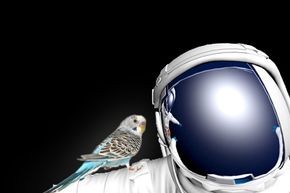 “Birds would actually do quite well in space. See more astronaut pictures.Photographer: Tobkatrina Agency: Dreamstime.com
“Birds would actually do quite well in space. See more astronaut pictures.Photographer: Tobkatrina Agency: Dreamstime.com
The coolest part about a spaceship or space station orbiting Earth is the weightlessness. It’s cool to humans because in weightlessness anyone can fly. You simply kick off of a wall and you can fly in a straight line to the other side of the ship without any effort. If you’ve seen video of astronauts clowning around on the space shuttle or in the space station, then you know that it looks like a lot of fun!
So what would a bird do in the space station? No one has ever really tried it, probably because of the hygiene problems. But if you had a big open space in the space station and released a bird into it, what would the bird do?
Think about what a bird does on Earth. It flaps its wings a lot to take off, it flaps its wings while it’s flying to stay in the air, and then it flaps its wings a lot when it lands to decelerate. Some birds, like hawks, are extremely good at gliding. They can stay in the air for long periods of time without any flapping once they’re airborne.
In space, a bird would need to do the same sorts of things at both ends of the flight. It would need to flap a lot at the beginning to build up some speed, and it would need to flap a lot at the end to slow down (or it could do what humans do at the end of their weightless flights and run into a wall). In the middle of the flight, the bird would simply glide. It doesn’t have to expend any energy during the flight because gravity isn’t pulling it down.
The big advantage that a bird would have over human beings in this situation is its wings. Inside a space station full of air, the bird’s wings and tail would still work fine. So the bird can turn, accelerate and decelerate mid-flight. Humans can’t do this — once a human kicks off the wall, the flight is pretty much a straight-line until the human hits the opposite wall. Birds would have a tremendous amount of control while flying in the space station if they used their wings and tails properly, although they would have to make some serious adjustments to compensate for their weightlessness.
The lingering, unknown question is this: Is a bird smart enough to adjust to things in a zero-gravity environment? Or is flying in gravity so instinctive that a bird can’t adjust? Birds are remarkably smart, so chances are that a domesticated bird would figure it out with a little practice.
Originally Published: Dec 5, 2007
Lots More Information
Related HowStuffWorks Articles
- How Space Stations Work
- How Space Shuttles Work
- How Weightlessness Works
- How Spacesuits Work
- How do I become an astronaut?
More Great Links
- NASA: Astronaut Selection
- NASA Astronaut Biographies
- How to Become an Astronaut 101
- The Ultimate Field Trip: An Astronaut’s View of the Earth
- So You Want To Be An Astronaut?

































